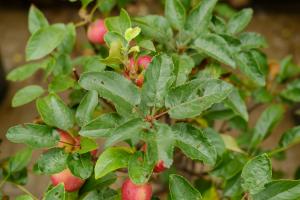Introduction
Tomatoes are a popular summer crop that requires warm temperatures and plenty of sunlight. As fall approaches and temperatures start to drop, it’s time to start thinking about what to plant after tomatoes. In this article, we’ll explore some of the best crops to plant in the fall after your tomato plants have finished producing.
Green Leafy Vegetables
One of the best options for fall planting after tomatoes is green leafy vegetables. These fast-growing crops can be grown in small spaces and are perfect for container gardens. Some of the most popular green leafy vegetables include spinach, lettuce, and kale. These crops can be grown from seeds or transplants and require consistent watering and plenty of sunlight. Additionally, they can be harvested multiple times throughout the season, making them an excellent choice for home gardeners.
Root Vegetables
Another great option for fall planting after tomatoes is root vegetables. These crops grow well in cool temperatures and offer a wide range of nutritional benefits. Some of the most popular root vegetables include carrots, beets, and turnips. These crops can be grown from seeds and require well-draining soil and plenty of sunlight. In addition to being nutritious, root vegetables are also versatile and can be used in a variety of dishes, from soups and stews to roasted dishes.
Cruciferous Vegetables
Cruciferous vegetables, such as broccoli, cauliflower, and cabbage, are another great option for fall planting after tomatoes. These crops require cool temperatures and plenty of sunlight to grow successfully. Additionally, they are highly nutritious and offer a variety of health benefits. Cruciferous vegetables can be grown from seeds or transplants and require consistent watering and fertilization. They can be harvested multiple times throughout the season, making them an excellent choice for home gardeners.
Garlic and Onions
Garlic and onions are both great crops to plant in the fall after tomatoes. These crops require cool temperatures and can be planted in the fall and harvested in the spring. Planting garlic and onions in the fall allows them to establish roots over the winter months, resulting in larger and healthier bulbs. These crops can be grown from bulbs and require well-draining soil and plenty of sunlight. Additionally, they are a staple in many dishes and offer numerous health benefits.
Conclusion
In conclusion, there are many great options for fall planting after tomatoes. From green leafy vegetables to root vegetables and cruciferous vegetables, there are a variety of crops that can be grown successfully in the fall. Additionally, garlic and onions offer a unique planting opportunity and can be harvested in the spring. By selecting the right crops and providing them with proper care and maintenance, home gardeners can enjoy a bountiful fall harvest.

 how many times do yo...
how many times do yo... how many planted tre...
how many planted tre... how many pine trees ...
how many pine trees ... how many pecan trees...
how many pecan trees... how many plants comp...
how many plants comp... how many plants can ...
how many plants can ... how many plants and ...
how many plants and ... how many pepper plan...
how many pepper plan...





























